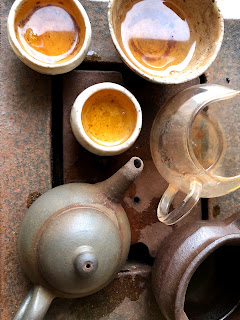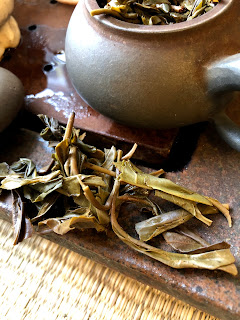This fine sample made it to me free in a recent yixing
teapot order along with these others (here and here). The description on the Essence of Tea website
for this Guafengzhai states, We left some yellow leaves in this cake since the quantity was so small and priced it accordingly. This gives a good range of flavours in the resulting tea. This is something interesting and new. I have not ever
heard of this before but it makes sense to me as a possible way to both add
depth of taste as well as to help keep the price down (because this region is
pretty expensive these days). It appears
that this 2018 Spring Guafengzhai has just recently sold out but used to go for
$224.00 for 200g cake or $1.12 /g .
The dry leaf smells amazing, like puerh candy with a layered
high noted sweetness and subtle rainforest sensibility. “This will be good tea” I think to myself…
The first infusion has a nutty roasted squash taste which
transitions to bold pungent flavours then into a quick moving splash of
returning sweetness. The mouthfeel is
gummy, and sticky and nice. There is sticky
rice base taste throughout and intense sweet tastes pop up here and there.
First infusion shows nice signs of complexity.
The tea pours a golden yellow colour that is similar to the 2018 Spring Essence of Tea Yiwu. This might
have something to do with the long processing that David is a fan of or
maybe it is a product of the weather this spring in Yiwu? Or the addition of the huang pian (“yellow
leaves” or the big yellow mature leaves they usually discard when sorting the
picked leaf)? I’m unsure but it is
something I am not used to seeing in such young puerh.
The second infusion has an initial nutty sweet initial taste
mixed with a fair bit of pungency there is a squash like and sticky rice base
taste under the flavours, slight wood.
The returning sweetness has a cooling menthol finish with light, soft
candy like sweetness. The throat feel is
medium depth and the mouthfeel is soft and slightly sticky.
The third infusion has a slightly woody, swash, nutty onset
which transitions to a long pungent taste where sweetness returns. At first the sweetness is a minty pungent mix
then it trails off into a mild candy-like sweetness. The mouthfeel has a mild tingling feeling.
The fourth infusion has the same woody, squash like, nutty
onset but it is leaning towards less nutty now and more woody. The pungency is a touch less now or maybe it
just carries a squash like sweet taste.
The sweetness unravels into a mild candy sweetness. The mouthfeel is
mild and the mild throat opens unpretentiously. The qi slowly and gently builds
up in the body.
The fifth infusion has a more cohesive taste to it now woody
even savory onset that transitions to pungency then to sweetness. The initial taste has shifted a bit here the
throatfeeling is on the edges of constriction in the mid throat. The mouthfeel has a mild sticky, almost
dryness to it.
The sixth infusion starts with an almost juicy nutty
treading toward bitter but not quite onset.
The taste transitions to more woody then to a soft quick pungency then
to a woody, almost watermelon and squash sweetness and less an intense candy
sweetness.
The seventh starts with a nutty squash like taste with
undertones of wood and pungency. The
sweet returning taste is less now and mixed with a menthol pungency.
The eighth begins a slight almost milky woodiness with and
ending nutty taste and returning pungency that is cooling and not as
sweet. The qi is a nice relaxing Qi but
not overly present. The physical body feels like its floating a bit. The mind relaxed.
The ninth has a woody and nutty onset with a mild pungency
and faint on the breath returning sweetness. It weakens here and seems to need
pushing early on.
The tenth is pushed 10 seconds beyond flash and gives us a
pumpkin/ squash taste with an almost bready and woody like taste. The sweetness is almost a bread like
sweetness with a faint nuttiness lingering beneath.
The eleventh infusion is pushed 30 seconds and delivers a
woody, squash and sweet potato like taste.
The mouthfeel is shored up here and is almost silty in the mouth with a
nice woody pungency.
The twelfth is put under a 30 steeping is mainly dry
wood. Not too exciting, slightly drying
in the throat almost bitter finish with subtle suggestions of menthol. Qi is a mild relaxing kind of thing but
nothing notable really.
The thirteenth is a good 30 seconds plus and comes out
rather grainy and cereal tasting mainly with a slight pungency.
The fourteenth is long steeped and gives off a nutty almost
juicy but drier wood taste. The
mouthfeel is dry here and constricting in these long steeps.
I put it to an overnight steeping and get better results
with a very viscus full syrupy sweetness with fruits and gourd tastes and full
coating in mouth.
Overall, I would have never guessed this to be from the Gua
Feng Zhai producing area. The huang pian
leaves mixed in gives it an interesting and contrasting depth that you wouldn’t
normally experience in a Gua Feng Zhai puerh which is usually quite light and
pungent. It almost tastes autumnal,
unnami, deeper, and warmer. I wonder if
we are going to see more of this mixing of yellow leaves? It’s almost worth trying for this experience.
The qi is of medium- mild intensity and makes the body feel
as if it is floating at times and the mind feels a bit relaxed. The mouthfeel can be a bit off putting and
dry and almost constricting if this tea is pushed too hard. This tea lacks stamina and had to be pushed
hard early but then the dryness feeling in the throat and mouth are more
apparent.
Reflecting on my day, I felt pretty good drinking this
yesterday…
Peace




No comments:
Post a Comment